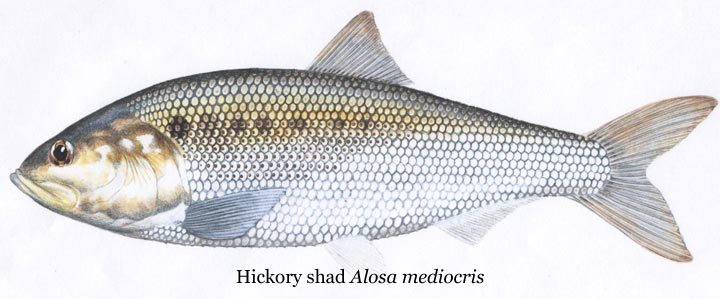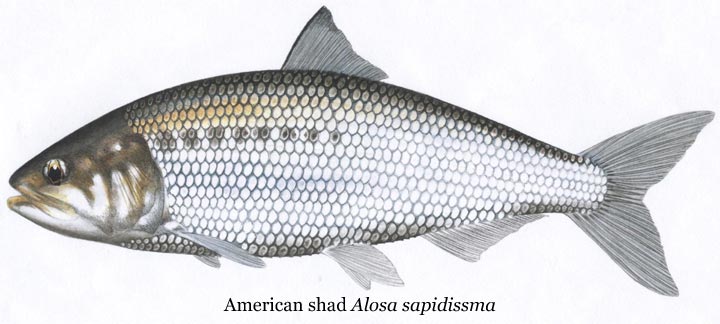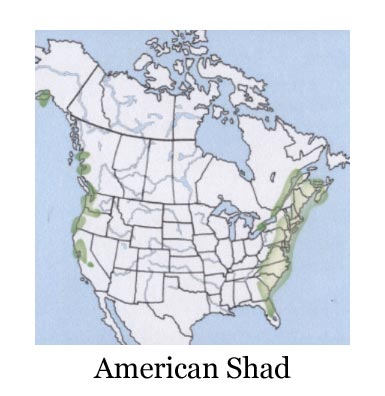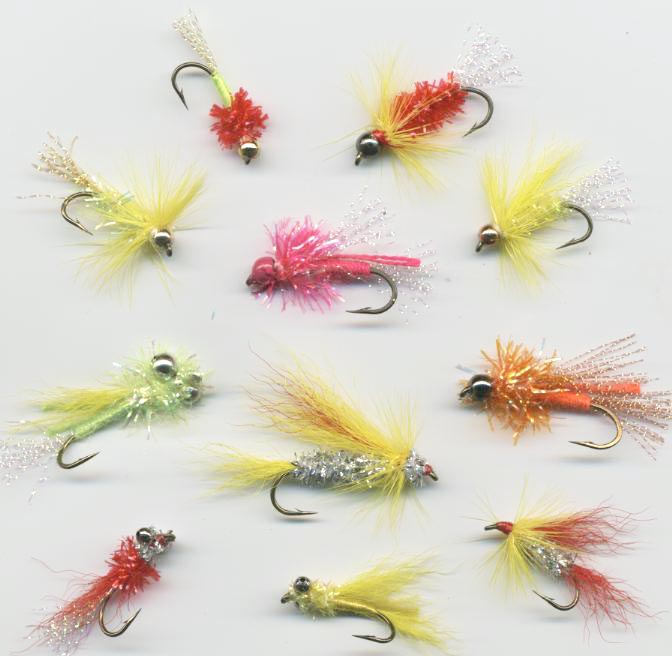Shad, February 2011, Fish of the Month!
Your source for flyfishing and flycraft resources since 1975.
Shad


 Local Names:
Local Names:
Hickory shad: Hick, Taylor shad
American shad: Shad, Common shad, Connecticut River shad,
Susquehanna shad, White shad
Average Size:
Hickory shad: 15 to 17 inches, 1 to 2 pounds
American shad: 16 to 24 inches, 1 to 8 pounds
Distinguishing Field Marks:
Both Species:
1. Deep, slab-sided body with large thin scales, large eyes, and smooth, bony scale-less heads.
2. There is no visible lateral line.
3. No adipose fin.
 4. The tail is deeply forked with both lobes of equal length.
4. The tail is deeply forked with both lobes of equal length.
Hickory shad:
1. With its mouth closed, the lower jaw extends slightly
beyond the upper.
2. Often shows rows of small dark spots on the body behind
the gill covers.
American shad:
1. With its mouth closed, the tip of the lower jaw fits into
a notch in the upper jaw and does not extend beyond it.
2. Only one row of dark spots extending backward from
the rear edge of the gill covers.
Fly Fishing for Shad
As you can tell by looking at the range maps for our two shad species, the Hickory shad does not occur on the west coast of North America. Three hundred years ago, neither did the American shad. Enterprising settlers, believing, perhaps, that they were “doing God’s work,” shuttled all manner of fish flesh all over creation. In fact, American shad were one of the earliest successful attempts at establishing various fish species in far flung waters. A MUST READ for anyone interested in fish culture and its results is An Entirely Synthetic Fish by Anders Halverson, Yale University Press, 2010, a very readable history of how fish got to where they got to……Very few places now where we can talk about real “native” fish species, eh?
It might be noted here that American and Hickory shad have recently been major beneficiaries of the removal of obsolete dams, beginning with the Edwards dam on the great Kennebec River at Augusta, Maine, 1999. More on all that in coming posts……
Diet:
Fly Fishing for both Species of Shad:
When in the river, shad tend to gather below wherever there is an obstruction to the flow, either natural or man-made. They also tend to move upstream along the river’s bottom. (I have heard of a large eastern Canadian river system where the shad are surface oriented, but this is definitely not the norm.) So, it behooves us who seek to connect with one of these excellent food and game fish to get our offering down as close to bottom as possible. Spin fishers typically use very small brightly colored lead headed jigs known as shad “darts.” For fly fishers, casting these tiny jigs is a possibility, although caution must used to avoid severing one piece of your favorite fly rod from another when a not so well aimed shad dart hits it at something close to warp speed…….under this type of stress, graphite is notoriously brittle. Historically, shad fly-fishers have tended toward the use of full sinking lines. Any one who has fished those lines can tell us that they’re not the easiest to maneuver. Fortunately, plastics technology has given the fly fisher a pretty wide range of sink-the-fly possibilities. Extra fast sinking tips and shooting heads are both excellent choices. Once the fishing depth issue is resolved (in whatever way suits your personal style) fly choice is not that much of a problem, although, if you’re not a fly-tier, you may have to do a bit of searching to find a supplier who carries shad flies. BUT, for an angler fishing shad as a new personal species, bonefish flies, bead-head trout nymphs, bead or cone head wooly buggers, or steelhead flies such as comets can be used. The good news? Shad flies need not be complicated. Plain and simple is the best approach. So, anyone even a little skilled at the fly-tying bench can put together a respectable shad fly. And, as you all might have already guessed, you need look no further than the Hook & Hackle on-line catalogue to acquire ANYTHING you might need to tie dozens of these little puppies. When you’ve got a bunch of ‘em, head to your chosen river, throw one out there and let it drift at or slightly faster than the speed of the current. If you’re a wet fly or nymph trout or salmon angler, you already know how to do this. Shad mouths are bony, but not made of steel either, so you don’t want to hit them too hard when they hit whatever it is you’ve thrown at them.
Oh yes, I almost left out some sage advice about choice of fly tackle…..O.K., shad, especially American shad, can grow to be pretty hefty animals AND they know all too well how to set those deep bodies of theirs across a strong river current and make the angler attached wonder if seeing the fish in hand is possible. Not only that, but “The Poor Man’s Salmon,” is a powerful runner and jumper…..All this by way of saying don’t go Elk hunting with a pea shooter. Personally, I’ve become a solid advocate of 10 foot fly rods on anything but very small streams. So, my recommendation would be a 10 foot 7, 8, or 9 weight rod and reel to match. The reel should hold a bare minimum of 100 yards of backing. For this reason, I don’t much care for “large arbor” reels. If I load the necessary yardage of Dacron backing on any size standard arbor fly reel, I’ve essentially made a “large arbor” under the line with the added comfort of knowing that when an unexpectedly large or stubbornly determined fish decides to head back to whatever ocean or lake is closest to it, I can let it “do its thing” and not need to worry about needing to quit fishing and go buy a new fly line before that fish is ready to come home to Daddy. I don’t like to throw added weight of any kind on my fly rods (not a “chuck & ducker,” this fish-head), so I go with hi-density sink tip lines, or detachable fast and extra-fast sinking “leaders” of varying lengths. The leader itself can be in the neighborhood of 3 to 6 feet, tapered or level, to suit your preferences. Fluorocarbon gets ooohs and ahhhhhs from lots of folks these days (partly because of its price) . Me? I’ve recently had a less than pleasant experience with a highly touted brand of fluorocarbon material and am now inclined to revert to the time tested old-fashioned monofilament. But again, I’ll leave those minute details (although they didn’t seem so minute to me when I lost 10 flies in one afternoon because of broken f.c. knots) to you folks out there in cyber-land. H&H purveyor of all things fly fishing Ron Weiss assures me that my next outing with H&H fluorocarbon leader will convince me not to go back to my “old ways.” He says, “Try it, you’ll like it.” Of course, I’m passing that line on to all you devoted readers of this column.
Below is a selection of Thompson contrived “shad flies.”
Simple enough, we think, that you don’t need tying instructions……

Don’t think of these as set patterns, but rather as jumping off points for your own imaginations’ flights of shad fly fancy. The bead heads and bead-chain eyes are obvious. Those that don’t have them have lead wire wrapped onto the hook before tying in the remaining materials.
Cheers you all, from Trout Thompson and the Hook & Hackle Company.
And remember, spring is always coming.






